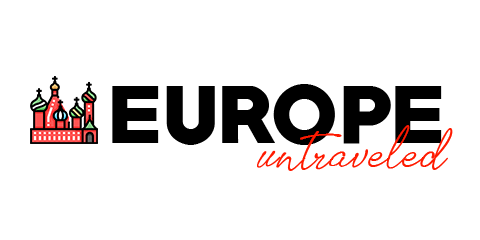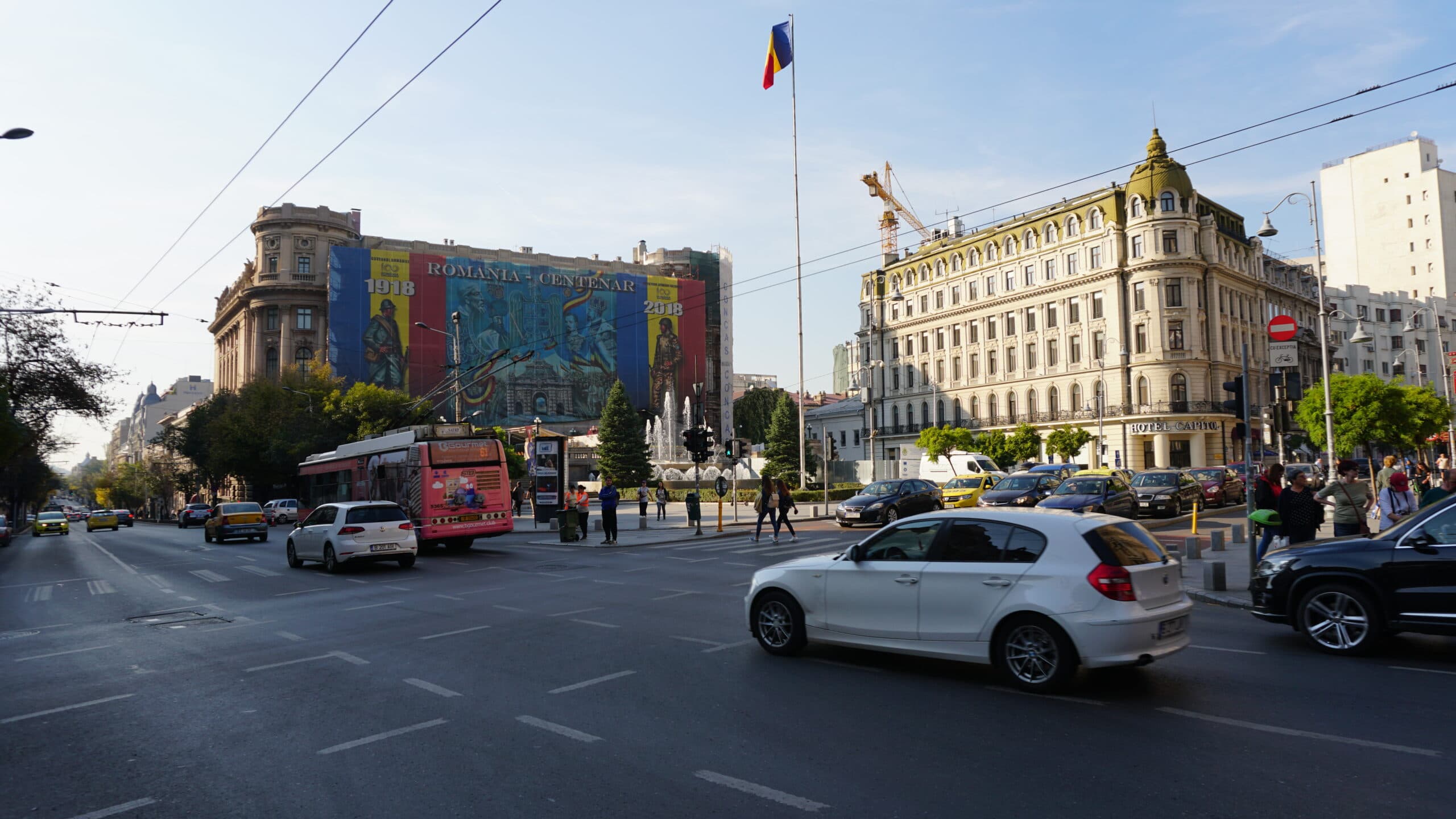What Language is Spoken in Romania?
Romanian is the official language of Romania and it is spoken by the majority of the population. It is a Romance language that is closely related to Italian and Spanish, with a unique influence from Slavic and neighboring languages. Romanian uses the Latin alphabet and has several dialects, including Moldavian and Transylvanian.
The vast majority of Romanians speak Romanian as their native language. Of Romania’s 19 million inhabitants, approximately 17.2 million are native Romanian speakers, or 90.65% of the population.
Romanian is a Romance language, making it similar to Spanish, French, Portuguese and Italian. Modern Romanian has been spoken on the territory of Romania since at least the 16th Century AD.
The modern Romanian language was formed over many centuries following the Roman conquest of Dacia in 106 AD by Emperor Trajan and the introduction of Latin.
Here is a breakdown of all languages spoken in Romania, together with number of native speakers:
| Language | Native Speakers | % of Population |
| Romanian | 17,177,000 | 90.7% |
| Hungarian | 1,260,000 | 6.7% |
| Vlax Romani (Gypsy) | 246,000 | 1.3% |
| Ukrainian | 49,000 | 0.3% |
| German | 27,000 | 0.14% |
| Turkish | 25,000 | 0.13% |
| Russian | 19,000 | 0.10% |
| Crimean Tatar | 18,000 | 0.09% |
| Serbian | 17,000 | 0.09% |
| Slovak | 13,000 | 0.07% |
| Bulgarian | 7,000 | 0.03% |
| Italian | 3,000 | 0.03% |
| Greek | 3,000 | 0.02% |
| Czech | 2,000 | 0.01% |
| Polish | 2,000 | 0.01% |
In addition to Romanian, there are several minority languages spoken in modern-day Romania. Notably among these are Hungarian, Ukrainian, German, and Turkish.
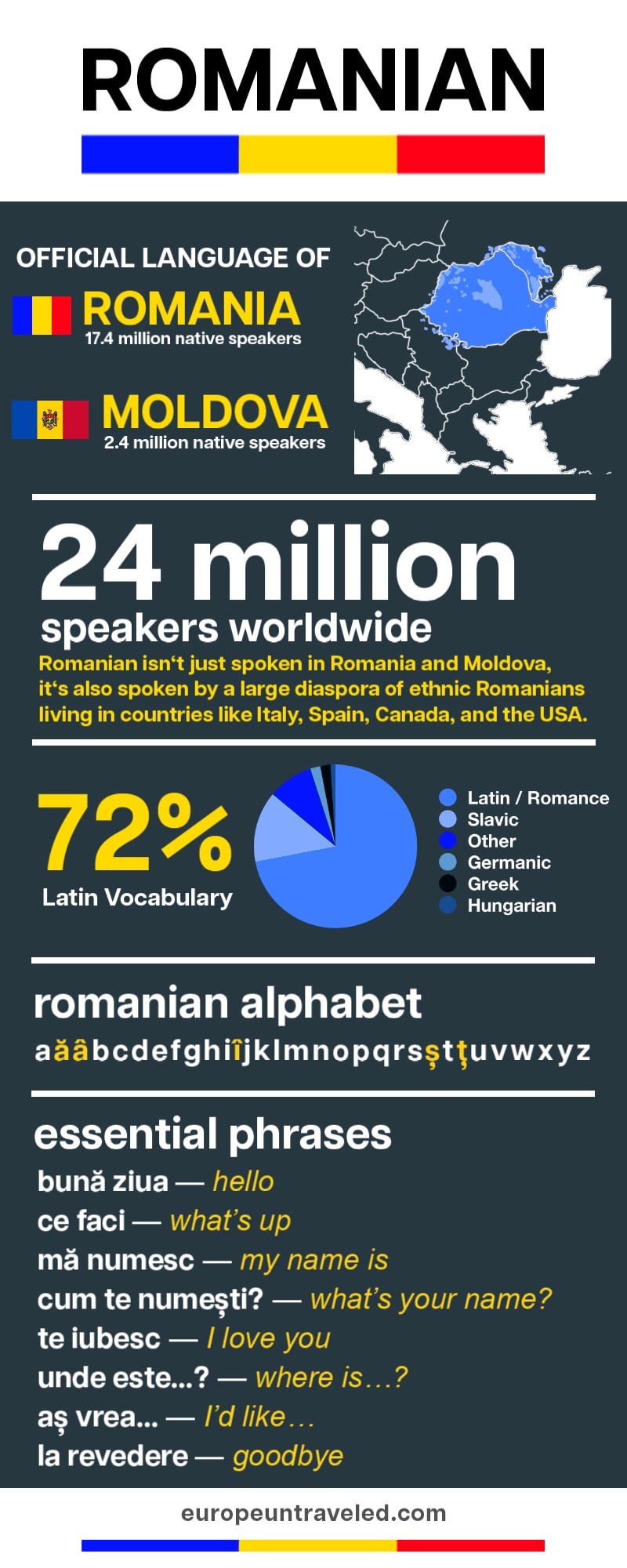
Romanians Speak English as a Second Language
English is widely spoken as a foreign language in Romania, with Approximately 15% of Romania’s population claiming they can carry on a conversation in English. Young people in Romania are even more likely to speak English, as 99% of Romanian school pupils study English as a foreign language.
Romanians, and young Romanians in particular, are some of the best non-native English speakers in the world. In fact, one survey ranked Romania 16th worldwide for levels of English proficiency in the country, placing it ahead of France, Italy, and Greece.
If you travel to Romania without knowing Romanian, you can certainly get around on English.
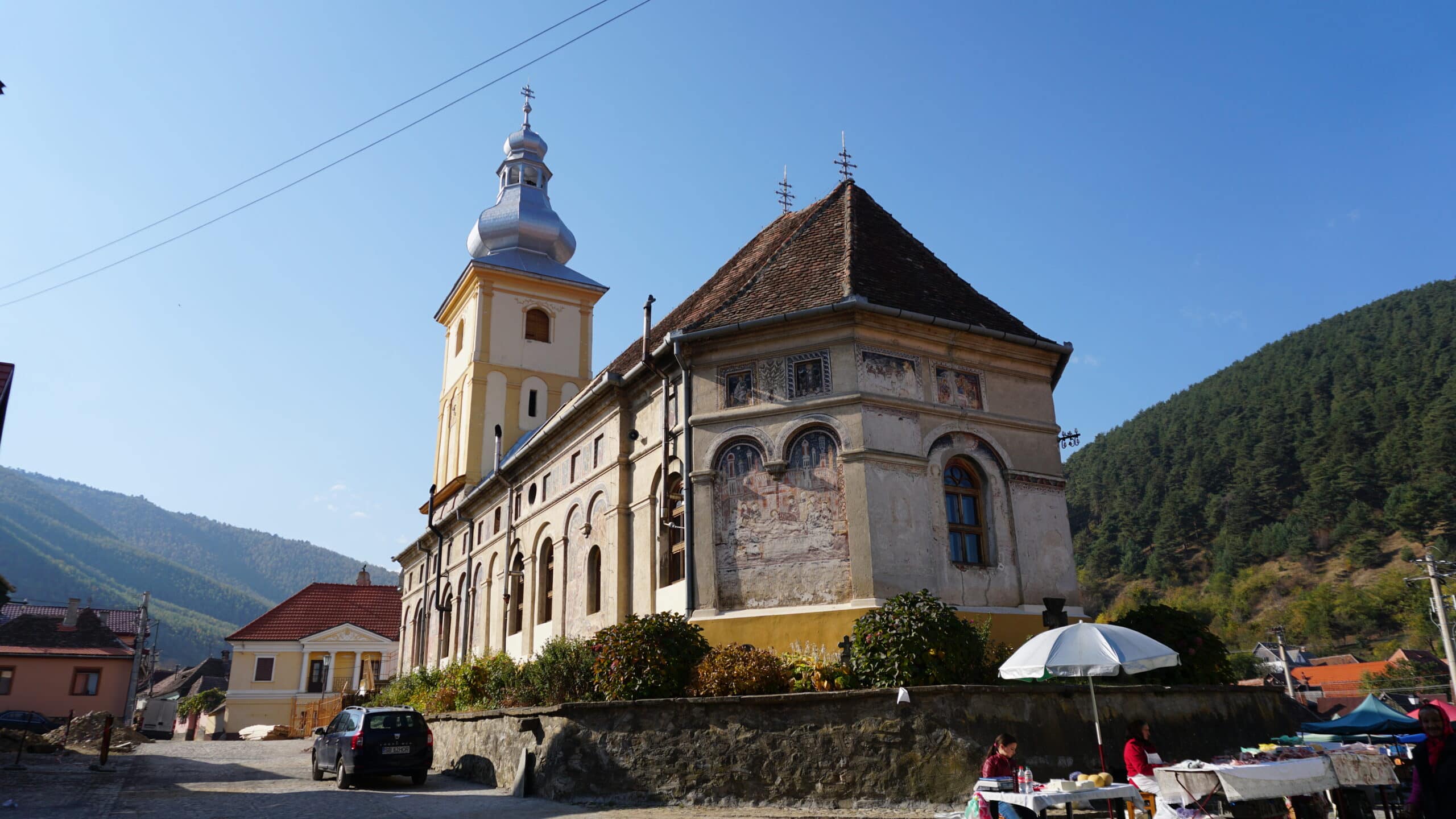
Where is Romanian Spoken?
Romanian is primarily spoken in Romania and Moldova, as it is the official language of both countries. There are approximately 24 million native Romanian speakers in the world, and around 17 million of them live in Romania. Romanian is also spoken by small pockets of ethnic Romanians living in Ukraine, Serbia, and Hungary.
It should come as no surprise that the vast majority of native Romanian speakers live in Romania. In fact, nearly 72% of native Romanian speakers are currently living in Romania. But, what about the other 28%? As it turns out, Romanian speakers can be found outside Romania’s borders, as well.
In the small country of Moldova, 77% of the 2.6 million-person population speaks Romanian as their native language. Romanian is the official language of Moldova and many Moldovans consider themselves ethnically Romanian.
Interestingly, Romanian can also be heard being spoken in isolated villages in regions of Ukraine, Serbia, and Hungary. Most of these communities are populated by ethnic Romanians and aren’t far from the Romanian border.
In recent times, Romanians have spread out and brought their language to more remote parts of the world. Following Romania’s addition to the European Union in 2007, many Romanians left abroad for countries like Germany, Spain, and Italy.
Here’s an overview of countries with a significant population of Romanian speakers:
| Country | Native Romanian Speakers |
| Romania | 17,263,000 |
| Moldova | 2,588,000 |
| Italy | 798,000 |
| Spain | 798,104 |
| United States | 367,000 |
| Ukraine | 328,000 |
| Germany | 300,000 |
| Israel | 212,000 |
| Transnistria | 177,000 |
| Russia | 160,000 |
| Canada | 110,000 |
| United Kingdom | 68,000 |
| Portugal | 53,000 |
| France | 50,000 |

What is the Romanian Language Like?
Romanian is a unique and vibrant Romance language. If you take a look at a map of Europe, you’ll notice that Romania is geographically isolated from other Latin countries, and most of its neighbors speak Slavic languages.
Romania’s unique geographical and political history have caused the Romanian language to evolve in surprising ways and it has taken on a novel character of its own.
Is Romanian a Romance Language?
Romanian is a Romance language and is similar to other Romance languages such as Italian, French, and Spanish. Many words in Romanian are borrowed from other Romance languages—particularly French—and Romanian pronunciation is quite similar to Italian. Of the five Romance languages, Romanian is the least widely-spoken.
Romance languages are the languages descended from spoken Latin, or Latin Vulgaris. The primary Romance languages are Spanish, French, Italian, Portuguese, and Romanian.
While Romanian is definitively a Romance language, it does have some quirks that make it a bit different from the other Romance languages.
For example, it has some Slavic vocabulary. Due to Romania’s geography and closeness to countries like Bulgaria, Serbia, and Ukraine, the Romanian language has quite a few words derived from Slavic. This makes it different from the other Romance languages, which are largely isolated from any Slavic influence.
In addition to its Slavic quirks, Romanian also has subtle influences from Dacian (the language spoken in the region before it was conquered by the Romans), Greek, and Turkish.
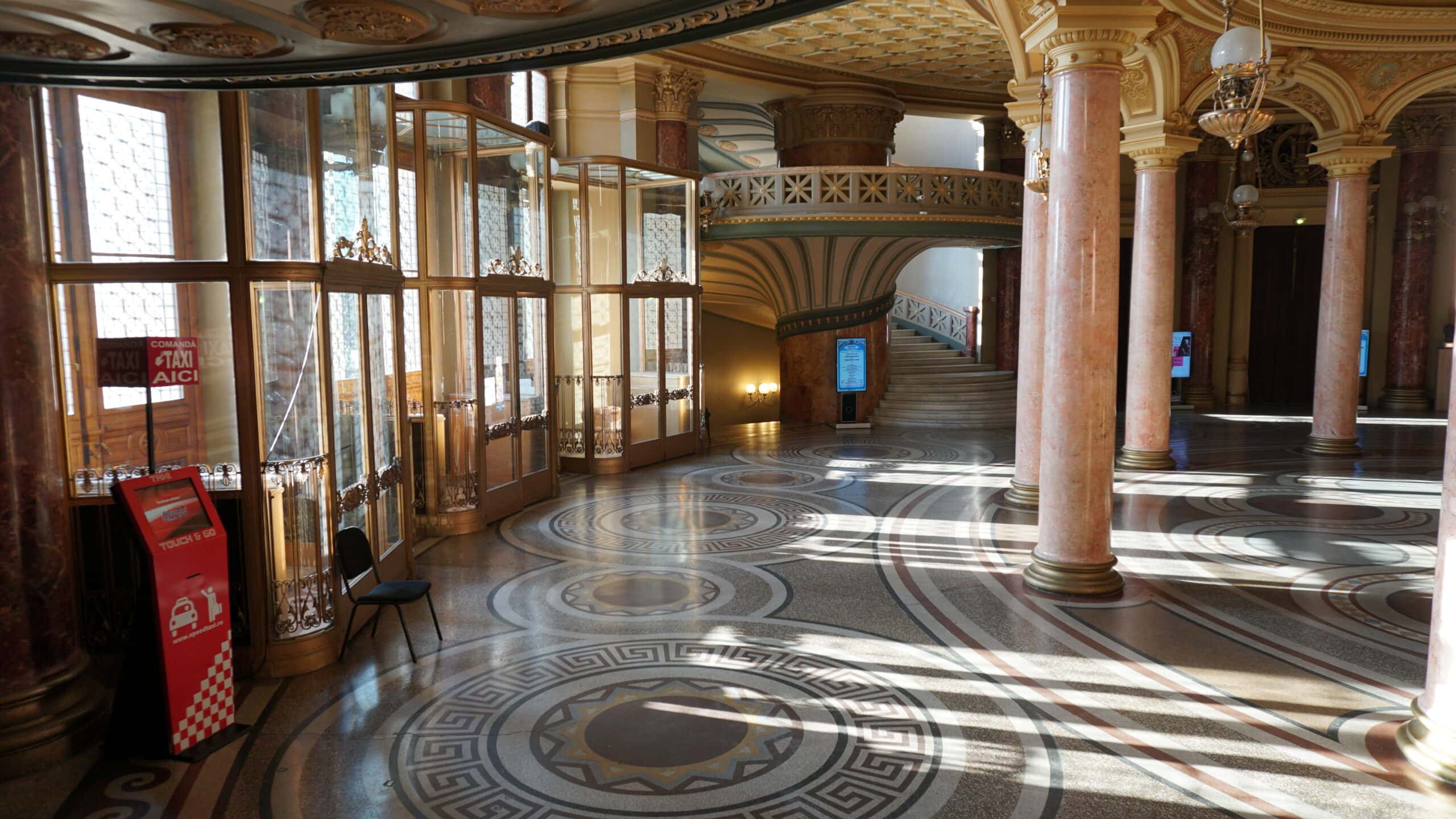
What does Romanian Sound Like?
Romanian sounds somewhat similar to spoken Italian. It is a Romance language with trilled r’s and Latin vocabulary. However, Romanian also has some features associated with Slavic languages like Russian. For example, the Russian sound “ы” exists in Romanian as “â”, but it does not exist in other Romance languages.
When hearing spoken Romanian for the first time, many English speakers remark that Romanian sounds like “Italian with a Russian accent”. This isn’t too far from the truth, since Romanian is essentially a Romance language with bits of Slavic influence.
It’s important to note, however, that Romanian pronunciation is very diverse. The language has a number of regional accents and dialects, and it tends to sound different from region to region.
Notably, in the East (Moldova), Romanians speak with a good deal of Slavic twang, and tend to use a slightly more Slavicized vocabulary. In the West, on the other hand, the language has a slower cadence and clearer pronunciation.
To give you an idea of what spoken Romanian sounds like, here are a few audio samples from a range of speakers.
Bucharest Accent
This clip is a good representation of the colloquial accents you might hear in Bucharest, the country’s capital. The Bucharest accent is considered standard, and it’s the accent you’ll hear spoken on the news.
Transylvania Accent
While this clip is a bit exaggerated for comedic effect, it’s a good representation of a rural Transylvanian accent.
Moldovan Accent
The Moldovan accent, which comes from the eastern region of the country, is famous in Romania. It has a reputation for being rural, and it’s sometimes characterized as a “lower-class” accent, especially in Bucharest.
Languages Similar to Romanian
Romanian is quite close to all of the Romance languages, but it is most similar to French and Italian. Over the centuries, Romania’s academic elite have imported a considerable degree of French vocabulary into the Romanian language. Phonetically, Romanian is highly similar to Italian and the two languages have very similar pronunciation.
In recent history, the Romanian elite have tended towards Francophonie, exhibiting a profound fondness of and closeness with French culture.
Some of Romania’s greatest thinkers, writers, and artists have been educated in France where they achieved great acclaim. George Brancusi, Emil Cioran, George Enescu, and many other Romanian greats made their careers in France.
This frequent contact between Romania’s educated elite and the French-speaking world has resulted in a slew of French words making their way into the Romanian language.
In fact, more than half of the Romanian vocabulary is estimated to come from either Latin Vulgaris (30%) or French (22%).
From a pronunciation perspective, however, Romanian is most similar to Italian. Broadly, Romanian and Italian are pronounced and written in nearly the same way.
Both Romanian and Italian feature open vowel sounds like a, o, e, i, and u. Both languages have trilled r’s and c sounds that soften when they precede certain vowels; for example, cibo is pronounced in Italian like “cheebo” and cina is pronouced in Romanian like “cheenah”.
There are additional similarities, as well. For example, both Romanians and Italians use “ciao” as a greeting, and it’s pronounced the same way in both languages.

Where Does The Romanian Language Come From?
The Romanian language comes from the introduction of Latin to the lower Danube River Basin following the Roman Empire’s conquest of Dacia in 106 AD. In the centuries following the Romanization of Dacia, the Romanian language continued to evolve, incorporating elements from Greek, Turkish, French, and Hungarian.
The precise origins of the Romanian language are hotly disputed by Romanian scholars. What’s for certain is that the language is derived from Latin, the language spoken by the Romans who conquered Dacia in 106 AD.
It’s disputed to what degree the Romans succeeded at stamping out the Dacian language, and it’s unclear the degree to which the modern Romanian language retains any real Dacian influence.
Here are some words in Romanian which are purported to have Dacian origins:
- brad – fir tree (Christmas tree)
- căciulă – cap/beanie
- leagăn – swing
- pânză – web
- sâmbure – seed/pit
While some elements of the Dacian language are preserved in modern Romanian, they aren’t very significant.
The modern language is primarily an amalgamation of Latin, Romance languages like French, and neighboring languages such as Greek, Turkish, and Hungarian.
